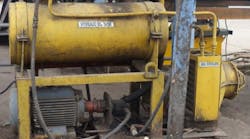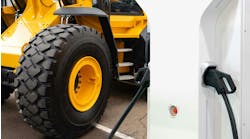When positioning a forced air heat exchanger, it should be situated so that it is at least half the fan diameter clear of any obstructions on both sides of the core. I recommend connecting the exchanger so that oil flows from bottom to top, or if the tanks are on the sides, from lower connection (inlet) to upper connection (outlet). The reason for this is to purge all air from the unit quickly and fill it completely for maximum efficiency.
The other connection issue for forced air heat exchangers, which requires attention during initial installation, relates to whether it is single or double pass. These days, many exchanger cores are designed so that during manufacture, they can be configured as either single or double pass. This means they have at least 3 ports - two ports in one tank and one port in the other (see exhibit 1). A single pass exchanger is converted to double pass by the insertion of a fully welded baffle in the middle of one of the tanks at the factory. This makes the oil flow down one half of the exchanger core, and then back up the other half.
Exhibit 1. Heat exchanger configuration.
Considering the diagram in exhibit 1, if the exchanger is single pass (no baffle in the top tank), I would connect the exchanger so that port C is the inlet and either port A or port B (but preferably port B) is the outlet. BUT, if the exchanger is double pass, the correct connection is port A inlet, port B outlet (or vice versa).
Note that if the unit is double pass and the technician doing the initial installation is not on the ball, he'll likely connect the unit in such a way that port C is used. Doing so means that only half the exchanger is effective. That is, if connection is made using ports B and C, only the right-hand side of the cooler is effective. If connection is made using ports A and C, only the left-hand half of the cooler is effective.
Believe it or not, I've seen this happen more than once. But it's not hard to detect this mistake - because of the large temperature variation between the two sides of the exchanger. And to discover six other mistakes you want to be sure to avoid with your hydraulic equipment, get "Six Costly Mistakes Most Hydraulics Users Make... And How You Can Avoid Them!" available for FREE download here.


